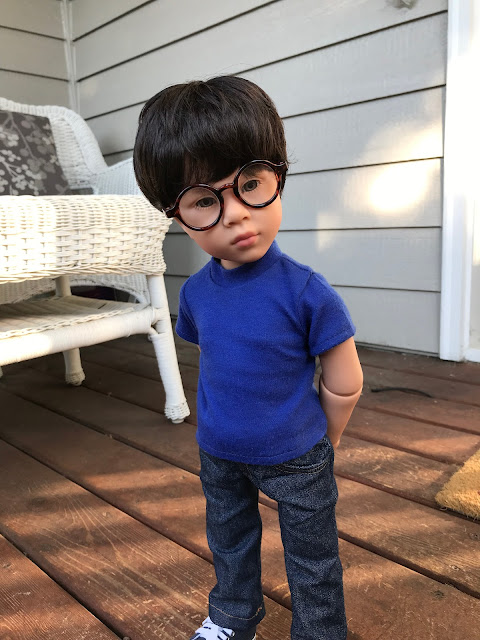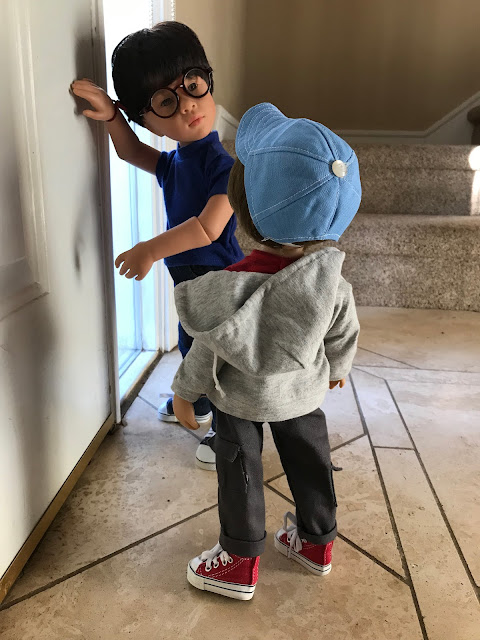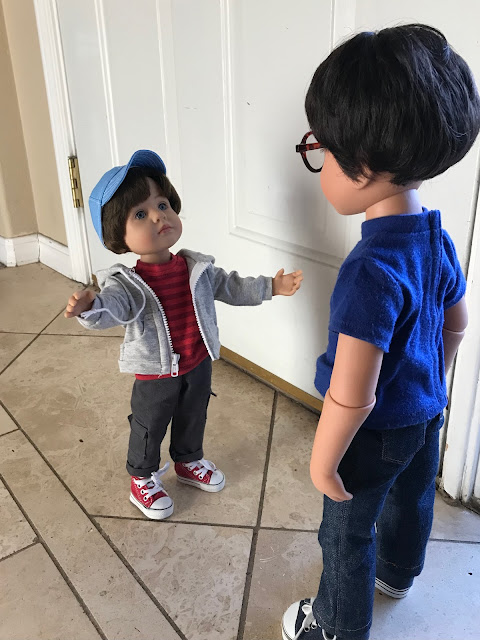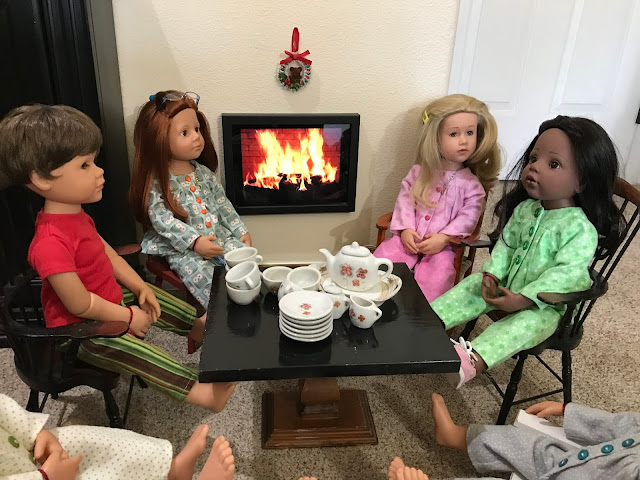"Emil," Pauly said, as the older doll let him in through the front door, "the tree in your neighbors' front yard is changing its clothes! How does it do that?"
Emil thought he knew what Pauly was talking about, but it was better to look and see. The two dolls went back out onto the front porch, and Pauly pointed. "See?" he said.
Just as Emil thought, Pauly meant the tree across the street that had changed its leaves from green to red.
"That's not all," Pauly continued, once he knew that Emil had seen the tree he meant, "the tree behind the house is doing the same thing, and other trees are changing their clothes, too."
Emil knew this, but he thought he would let Pauly say everything he wanted to say. Emil, like most dolls, is a good listener.
"Not only that," Pauly went on, "Jeffy took me along when he went for a drive with his parents up into the mountains, and there were other trees there that were changing their clothes."
"Some of them," he said, "were putting on red leaves, and some of them were dressing themselves in yellow leaves."
The two dolls turned to go back into the house. "I don't know what they did with their green leaves, though," he said. "They can't walk, I don't think, so who takes the green ones away? I don't know how they put them on, either, I never saw any of them reach down and pick up a new leaf to put on, and who brings them the red and yellow leaves to wear?"
It was beginning to dawn on Emil that Pauly had the process a little confused. "Actually, Pauly," he said, "they are dropping the leaves, not picking them up."
Pauly looked at Emil and thought about that.
"Why would they drop them after they just put them on," he asked.
"You see," Emil explained, "those red or yellow leaves––or sometimes orange leaves––are the same leaves they've been wearing all summer. They change color in the fall. Come into the dining room. Mandy and I were just getting ready to do our homework there. We can talk about it."
"I was puzzled by that, too, when I first got here," Emil continued as they started walking. "It was just about this time of year, and the leaves already looked this way, so I thought the colors we see now were normal, but they were changing. Later on, when they looked different, I thought there was something wrong with my special glasses. You've been here all summer. Those trees have always been green until now. It's a big surprise, isn't it, until you know what's happening?"
"Lots of things are that way," Pauly pointed out. "I'm beginning to realize that."
"The trees aren't putting the leaves on," Emil said. "They grow them in the spring. the leaves start out as tiny buds, then grow and unfold until they're as big as they are now."
"When you came in May," Emil continued as they walked through the living room, "the trees already had their leaves, and they were green. This time of year the trees that have those big leaves start to change color, and then the leaves drop. The trees just let go of them, and the leaves fall to the ground. In the winter, they won't have any leaves at all. The sun will go down earlier and earlier, and it will be cold outside."
"Won't the trees be cold?" Pauly asked. He always pretended to be cold when the temperature outside was cooler. Then Jeffy dressed him in a sweater or his hoodie.
"No," Emil said. "I think they sort of go to sleep for the winter, like bears do, so they don't feel the cold."
"Why do they change their color if they're just throwing them away?" Pauly asked, as they reached the table in the dining room, where Emil and Mandy were going to be doing their homework.
"I don't know," Emil said. "Billy and I asked Mandy about why the leaves were green, and she said that something called chlorophyll (KLOR-oh-fill) makes the leaves green, and the plants use it along with air, water and light to make food to live on. I think the trees drop the leaves because they're used up, or because they don't need them in the winter, but I don't know why they change color."
"That sounds like a Mandy question," said a laughing voice from the the table. It was Mandy, of course. She had heard part of the conversation...enough to figure out what they were talking about.
Emil and Pauly went around to the chair by the window and climbed up on it. "Pauly and I want to know why the leaves change color before they fall from the tree," Emil told her. "I knew the leaves were green because the chlorophyll makes them green. I was just guessing that the chlorophyll was used up, but I don't know why that would make the leaves red or orange or yellow."
"Well," Mandy said, closing her book and moving her glasses to the top of her head, "you're right; the chlorophyll makes the leaves green, and it sort of gets used up when the trees stop making food to store for the winter, but they don't add the other color to the leaves. That color is always there. We just don't see it because of all the green from the chlorophyll."
"The color of the leaves in the fall," Mandy explained, "depends on the kind of tree, because each different type of tree has more red or more yellow besides the green from the chlorophyll."
"What do you suppose makes leaves orange?" Mandy asked the boys.
They had to think about that. Pauly was baffled. He just thought they must have orange color in the leaves, but the way Mandy asked made him think it was more than that.
Emil thought he knew, though. "Red and yellow make orange when you mix them," he said. "I'm guessing that trees that turn orange in the fall have some red and some yellow."
Mandy nodded. "Good thinking," she said.
"So the trees throw the leaves on the ground when they're done with them?" Pauly asked.
"Sort of," Mandy said. "The stems of the leaves dry up and weaken their hold on the tree when they aren't needed anymore. When the stem is too weak for the weight of the leaf, it breaks off and the leaf falls. Sometimes the wind or rain speeds that up."
"Some of the trees," Emil told Pauly, "don't change color at all, like the big fir tree in the front yard and all the junipers and pines in the woods."
"We call those 'evergreen trees,' Pauly," Mandy explained. "It's because they stay green all year. They're able to do that because they have very tough, skinny leaves or even needles. They're so tough and skinny, they don't freeze in the winter, so the tree can keep making food for itself, although less, because the sun goes down earlier and earlier in the winter, so there's less light. That's why we're already having to use the lights in house now, even though it's just late afternoon."
"Emil says the trees go to sleep for the winter," Pauly told her.
"That's right," Mandy agreed. "We say they 'go dormant (DOR-ment).' All the trees that lose their leaves go dormant in the winter. That means they don't do anything but rest."
Pauly had been running a worry in the back of his mind as the dolls were talking about the trees. "Do bears go dormant in the winter?" he asked then. "Emil said the trees go to sleep for the winter 'like bears do.'"
"Yes," Mandy agreed, "they do go to sleep for the winter, but with animals like bears, we say they hibernate (HY-ber-nayt). They go into their homes, curl up and sleep until spring. They live off their fat or food they've stored until fresh food starts to grow again in the spring."
"How long is winter?" Pauly asked. "Is it a long time?"
"It lasts about three months here," Mandy told him, "but it can be longer other places further north in our part of the world, and shorter further south, because winter is shorter there. Winter starts gradually as the days get shorter, and then it warms up slowly again in the spring, as the days get longer. Bears can hibernate for several months in places where the winter lasts longer. They sleep as long as they need to, maybe seven months in some places. They do it because it's hard to find food when nothing much is growing."
"You will like the winter, Emil told Pauly. "We will have snow. Snow is lots of fun!"
Mandy and Emil both realized Pauly was starting to look sad. "What's the matter, Pauly," Mandy asked. "You look sad."
"Jeffy's bear, Bye-bye, is my only friend at Jeffy's house," he said, "besides Jeffy and his parents. He's a toy, like me. Bye-bye tells me stories. He listens to me when I want to talk to someone and we're home alone. I can tell him about what I did at school."
"Three months is a long time!" Pauly cried. "That's almost as long as I've lived here! Bye-bye won't be able to talk to me if he's asleep!"
"Don't worry!" Mandy laughed. "Jeffy's bear won't need to hibernate. He's a toy, like us. He doesn't need to hibernate because he doesn't need to eat, except pretend, and he lives in a warm house with all of you."
"He won't need to go dormant like the trees, either," Emil assured him, glad to use one of his new words. "He will probably want to hear all about your adventures in the snow. You two will have lots to talk about."
Pauly got up. "Tell Pippa I said hi," he said, climbing down. "I think I need to go home and get a bear hug!"
With that, he was out the door and gone. It was going to start getting dark soon, anyway.
Mandy: Götz Happy Kidz Katie 2015
Emil: Götz Happy Kidz Emilia
"The Doll's Storybook" is not affiliated with Gotz Dolls USA Inc. or Götz Puppenmanufaktur International GmbH.
Watch for the next story each Friday afternoon at 1:00 PM Pacific Time.
<a href="https://www.bloglovin.com/blog/19832501/?claim=j3fj3mbb8kt">Follow my blog with Bloglovin</a>
Copyright © 2022 by Peggy Stuart
















































No comments:
Post a Comment